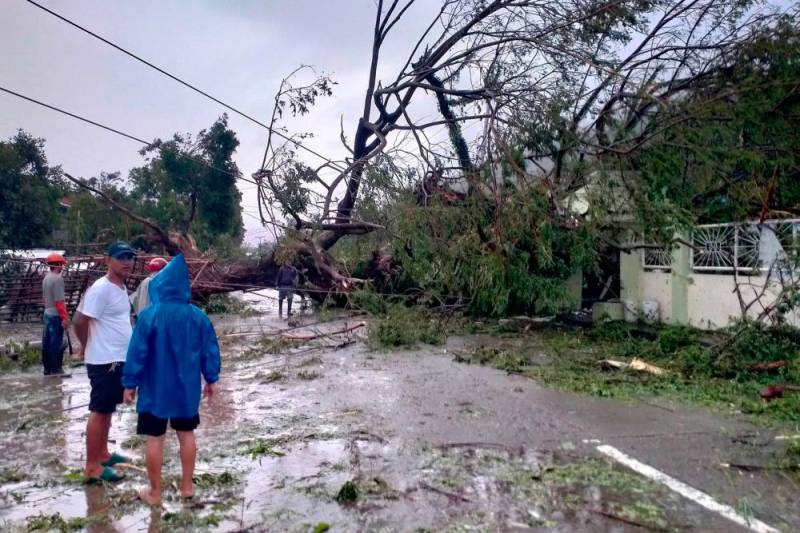Super Typhoon Man-yi fells trees, power lines in the Philippines

Stay tuned with 24 News HD Android App

Super Typhoon Man-yi uprooted trees, brought down power lines and ripped off corrugated iron roofing as it swept across the storm-weary Philippines on Sunday, following an unusual streak of violent weather.
Man-yi was still packing maximum sustained winds of 185 kilometres per hour (115 miles per hour) after making landfall on lightly populated Catanduanes island late Saturday.
More than 650,000 people fled their homes ahead of Man-yi as the national weather service warned of a "potentially catastrophic and life-threatening" impact from the storm.
"There have been no reported casualties, perhaps because people followed the evacuation orders," Catanduanes provincial disaster operations chief Roberto Monterola told AFP on Sunday, as clean-up efforts on the island got underway.
"All the towns sustained damage, but we expect those in the north to have more problems," Monterola said.
"It's just a breeze and a drizzle now."
Man-yi is expected to "slightly weaken" to a typhoon before hitting Luzon -- the country's most populous island and economic engine -- on Sunday afternoon, forecasters said.
Severe flooding and landslides were expected as Man-yi dumped "intense to torrential" rain over provinces in its path, with more than 200 millimetres (nearly eight inches) forecast in the next 24 hours, the weather service said.
Panganiban municipality in the northeast of Catanduanes took a direct hit from Man-yi.
Photos shared on the Facebook page of Mayor Cesar Robles showed toppled power lines, damaged houses, and trees and corrugated iron sheets strewn on the roads.
- 'Bursts of wind' -
"Pepito was so strong, I have never experienced a typhoon this strong," Robles said in a post, using the local name for Man-yi.
"It is still a bit unsafe there are still bursts of wind and there are many debris."
Marissa Cueva Alejandro, 36, who grew up in Catanduanes, said typhoons were getting stronger.
"Before, we would only experience (typhoon) signal number three to four, but now typhoons are getting as strong as signal number five," she said, referring to the weather service's five-tiered wind warning system.
Man-yi is the sixth storm in the past month to batter the archipelago nation. At least 163 people died in the previous storms, that also left thousands homeless and wiped out crops and livestock.
Climate change is increasing the intensity of storms, leading to heavier rains, flash floods and stronger gusts.
About 20 big storms and typhoons hit the Southeast Asian nation or its surrounding waters each year, killing scores of people, but it is rare for multiple such weather events to take place in a small window.
Robert Tancino, a government ambulance driver in Tiwi municipality in Albay province, which faces Catanduanes, said his area appeared to be largely unscathed.
"Not too many trees fell and the roads are otherwise clear. I did not see any damage among the houses here," Tancino told AFP.
- Resorts deserted -
The weather forecaster has hoisted its second-highest typhoon signal over several provinces along Luzon island's east coast where Man-yi is expected to make its second landfall.
Around 2,000 people were in emergency evacuation shelters in Dipaculao municipality in Aurora province.
Others have stayed home to protect their property and livestock, or because they were sceptical of the warnings, said Geofry Parrocha, communications officer of Dipaculao disaster agency.
"Some of our countrymen are really hard-headed. They do not believe us until the typhoon arrives," Parrocha told AFP.
Tourists emptied out of coastal resorts ahead of the typhoon.
"Our facilities are deserted," said Irene Padeo, reservation officer of the L'Sirene Boutique Resort in Baler town in Aurora, shortly before Man-yi was due to make landfall in neighbouring San Luis.
"Our outdoor items have all been packed and taken indoors. We tied down all the rest."
On its current trajectory, Man-yi will cross north of Manila and sweep over the South China Sea on Monday.
Man-yi hit the Philippines late in the typhoon season -- most cyclones develop between July and October.
Earlier this month, four storms were clustered simultaneously in the Pacific basin, which the Japan Meteorological Agency told AFP was the first time such an occurrence had been observed in November since its records began in 1951.
